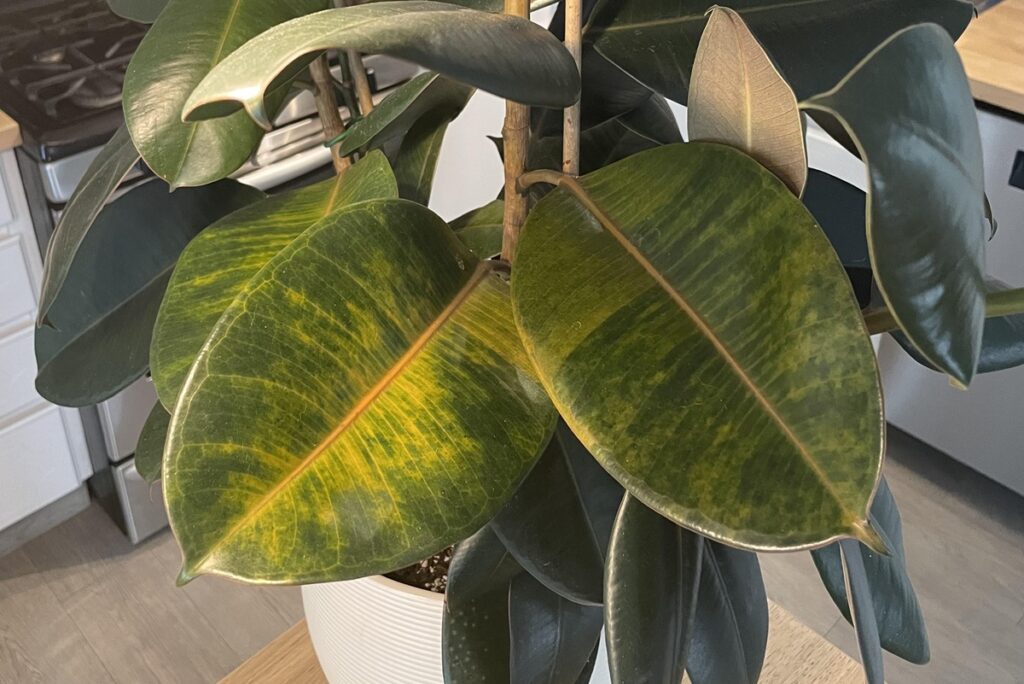Did you know that rubber plants can develop yellow leaves for up to eight different reasons, even when you think you’re following proper care guidelines? If you’ve noticed your rubber plant’s leaves losing their rich green color, you’re likely dealing with one of the most common houseplant issues that gardeners face. While yellowing leaves might seem alarming, identifying the specific cause will help you get your plant back to its vibrant self through some straightforward adjustments to its care routine.

Contents
Common Causes of Rubber Plant Leaf Yellowing
Rubber plant leaf yellowing typically occurs due to several common environmental and care-related issues. Overwatering is one of the most frequent causes, leading to root rot and preventing proper nutrient uptake. Insufficient light exposure can also trigger yellowing, as these plants need bright, indirect sunlight to maintain healthy foliage. Additionally, nutrient deficiencies, particularly lack of nitrogen, iron, or magnesium, can manifest as yellowing leaves.
Environmental stress factors play a significant role in leaf yellowing. Sudden temperature changes, cold drafts, or exposure to heating vents can shock the plant and cause yellowing. Improper humidity levels, pest infestations such as spider mites or scale insects, and natural aging of older leaves are other common triggers for yellow discoloration in rubber plants.
Overwatering and Drainage Problems
Overwatering is one of the most common causes of yellowing leaves in rubber plants. When soil remains consistently wet, it prevents roots from getting the oxygen they need, leading to root rot. The first signs typically appear as yellowing leaves, particularly on the lower portions of the plant, which may eventually drop off if the problem persists.
Poor drainage compounds the overwatering problem and creates an environment where root damage becomes inevitable. This can occur due to compacted soil, containers without adequate drainage holes, or using saucers that allow water to pool at the bottom. When roots sit in waterlogged soil, they begin to decay, making it impossible for the plant to absorb necessary nutrients and water, ultimately causing the leaves to turn yellow and the plant to decline.
Lighting Issues and Sun Exposure
Lighting issues and improper sun exposure are common causes of yellowing leaves in rubber plants (Ficus elastica). These plants prefer bright, indirect light, and when exposed to incorrect light conditions, they can develop yellow leaves as a stress response.
Too much direct sunlight can scorch rubber plant leaves, causing them to turn yellow or develop brown spots. Conversely, insufficient light can also trigger yellowing, particularly in older leaves, as the plant cannot produce enough chlorophyll to maintain healthy green foliage. The lower leaves are usually the first to show signs of inadequate light, becoming pale and eventually yellow before falling off.
The ideal location for a rubber plant is near an east-facing or north-facing window, where it receives bright, filtered light throughout the day. If placed near a south or west-facing window, use a sheer curtain to diffuse the intense afternoon sun. Regular rotation of the plant guarantees even light distribution and prevents lopsided growth.
Nutrient Deficiencies and Soil Health
Nutrient deficiencies are a common cause of yellowing leaves in rubber plants, with the most frequent culprits being nitrogen, iron, and magnesium deficiencies. When nitrogen is lacking, older leaves begin yellowing from the bottom of the plant upward, while iron deficiency typically causes younger leaves to yellow while the veins remain green. Magnesium deficiency appears as yellowing between leaf veins, starting with older leaves.
Soil health plays an essential role in preventing nutrient deficiencies, as poor soil conditions can limit the plant’s ability to absorb available nutrients. The ideal soil for rubber plants should be well-draining, rich in organic matter, and maintain a pH between 6.0 and 7.0. Compacted soil, improper pH levels, or soil that’s too wet or dry can all interfere with nutrient uptake, leading to deficiency symptoms even when nutrients are present in the soil.
Temperature and Humidity Concerns
Temperature and humidity play vital roles in rubber plant health, with improper levels often causing yellowing leaves. Rubber plants thrive in temperatures between 60-80°F (15-27°C), and sudden temperature fluctuations or exposure to cold drafts can stress the plant, leading to yellow foliage. Placing rubber plants near air conditioning vents, drafty windows, or heating units can create temperature inconsistencies that damage the leaves.
Humidity requirements for rubber plants typically range from 40-60%. When humidity levels fall below this range, especially during winter months or in air-conditioned spaces, the leaves may begin yellowing and develop brown edges. Low humidity causes moisture loss through the leaves faster than the plant can replace it, resulting in stress and leaf discoloration. Using a humidity tray, grouping plants together, or running a humidifier can help maintain appropriate moisture levels in the air.
Pest Infestations and Disease Management
Pest infestations and diseases can cause rubber plant leaves to turn yellow and must be addressed promptly to prevent plant decline. Common pests include spider mites, mealybugs, and scale insects, which feed on plant sap and weaken the foliage. These pests often appear as tiny spots, cottony masses, or shell-like bumps on leaves and stems, accompanied by yellowing leaves, sticky residue, or fine webbing.
Treatment options include wiping leaves with insecticidal soap, neem oil, or a diluted alcohol solution. Severely infested leaves should be removed, and the plant should be isolated to prevent pest spread to other houseplants. For fungal diseases that cause yellowing, such as leaf spot or root rot, infected areas should be pruned, and fungicides may be necessary. Proper air circulation and avoiding overwatering help prevent disease development.
